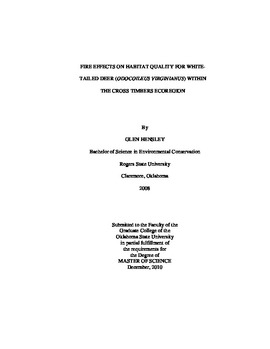| dc.contributor.advisor | Leslie, David M., Jr. | |
| dc.contributor.author | Hensley, Glen | |
| dc.date.accessioned | 2014-04-15T21:59:45Z | |
| dc.date.available | 2014-04-15T21:59:45Z | |
| dc.date.issued | 2010-12-01 | |
| dc.identifier.uri | https://hdl.handle.net/11244/9175 | |
| dc.description.abstract | Stable isotope ratios of carbon (13C/12C; expressed ?13C) and nitrogen (15N/14N; expressed ?15N) have been used to infer dietary composition of C3 and C4 forages and nutritional condition of herbivores. Indices such as fecal nitrogen also can be used to assess dietary quality of large herbivores. The objectives of this study were to assess the effects of varying fire prescriptions on white-tailed deer nutrition and condition in the Cross Timbers ecoregion of Oklahoma. Tissue samples (i.e., bone collagen, incisor enamel, muscle, liver, and hoof) were collected from 257 white-tailed deer during hunts in 2008 and 2009 at 3 Wildlife Management Areas (WMA), 1 State Park, and 4 State-operated check stations (representing private lands). Fecal samples were collected from 77 white-tailed deer in February-March, 2009 and 2010 at the 3 WMAs. Mean isotopic carbon (?13C) values of seasonal representative tissues, i.e., fecal (late-winter), liver (early-winter), muscle (autumn), hoof (summer) and bone collagen and incisor enamel (life-span tissues), suggested that diets of white-tailed deer in the Cross Timbers ecoregion of Oklahoma consisted mostly of C3 forages. Mean muscle ?15N increased at the 3 WMAs in the year following the application of fire. Mean hoof ?15N did not differ between years. Significant increases in mean bone ?15N were observed at the 3 WMAs as mean years since fire (YSF) decreased in the units in which white-tailed deer were harvested. Mean incisor ?15N did not differ between years at each WMA, but differences among WMAs did exist. Mean liver ?15N was significantly lower at Cherokee WMA in both years of this study than Okmulgee GMA and Lexington WMA, and a significant increase was observed at Okmulgee GMA following application of fire. Despite variability in the application of prescribed fire at the 3 WMAs, low values of YSF within theoretical home ranges in combination with levels of fecal ?13C, fecal ?15N, and fecal nitrogen suggested that white-tailed deer at the 3 WMAs selected home ranges with comparable nutrition in late-winter. | |
| dc.format | application/pdf | |
| dc.language | en_US | |
| dc.publisher | Oklahoma State University | |
| dc.rights | Copyright is held by the author who has granted the Oklahoma State University Library the non-exclusive right to share this material in its institutional repository. Contact Digital Library Services at lib-dls@okstate.edu or 405-744-9161 for the permission policy on the use, reproduction or distribution of this material. | |
| dc.title | Fire Effects on Habitat Quality for Whitetailed Deer (Odocoileus virginianus) Within the Cross Timbers Ecoregion | |
| dc.type | text | |
| dc.contributor.committeeMember | Shaw, James H. | |
| dc.contributor.committeeMember | Bidwell, Terrence G. | |
| dc.contributor.committeeMember | Hallgren, Steve W. | |
| osu.filename | Hensley_okstate_0664M_11169.pdf | |
| osu.college | Agricultural Sciences and Natural Resources | |
| osu.accesstype | Open Access | |
| dc.description.department | Department of Natural Resource Ecology and Management | |
| dc.type.genre | Thesis | |
| dc.subject.keywords | carbon isotopes | |
| dc.subject.keywords | cross timbers | |
| dc.subject.keywords | nitrogen isotopes | |
| dc.subject.keywords | odocoileus virginianus | |
| dc.subject.keywords | oklahoma | |
| dc.subject.keywords | years since fire | |
